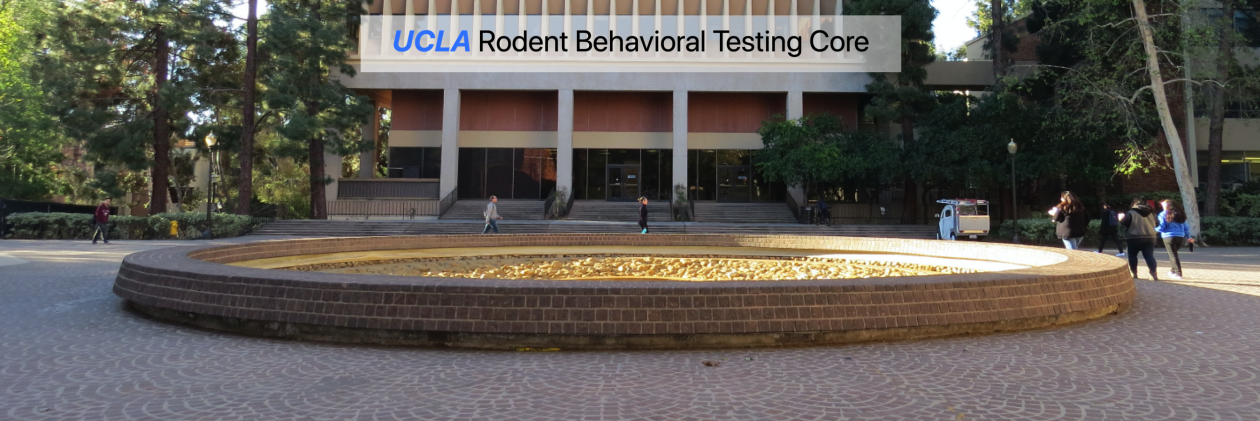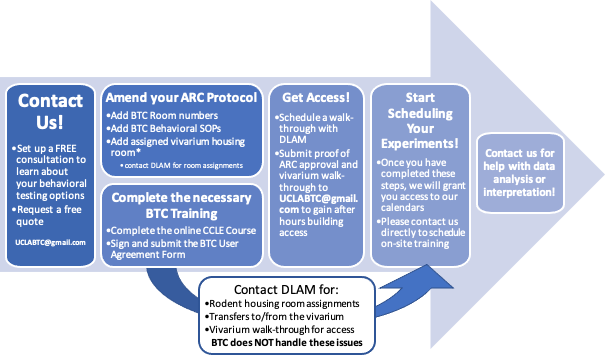Step 1: Review our Behavior Assays & Contact Us!
Currently available behavioral assays are listed under our Behavioral Tasks tab on the left panel. However, we are constantly expanding our testing capabilities. If you don’t see something listed, please contact us, and we will try to accommodate you.
To set up a free consultation, please email us at: uclabtc@gmail.com
Please include a few details, including a brief summary of your project, rat/mouse, self-performed or full service (staff performed). Feel free to include any relevant papers with the protocols you are interested in using. This will give us enough information to prepare recommendations for you at our appointment.
Step 2: Protocols & Training
After our initial consultation, your first goal should be updating your ARC protocol. We cannot move forward with any testing until you have approval. Approval of the ARC Protocol Amendments can take a couple of weeks to a couple of months, so please plan accordingly.
ARC Protocol:
First, update your ARC protocol to include the following information:
- Add our facility and testing rooms to your locations (currently Franz/Pritzker Hall B527, B533, B537, and B552)
- Add your DLAM-assigned rodent housing room.
- Please note, BTC does not have anything to do with room assignments or animal transfers. You must contact DLAM directly for any animal housing-related issues.
- Reference our ARC protocol 2002-130-61 and list which experiments you will be conducting (Rats 2.0 contains BTC written SOPs that you can insert)
- If you will be modifying your procedure from our currently approved protocol, you will need to describe the changes.
BTC Policy Training:
- All users must take a short online CCLE course and pass the quiz at the end. This course contains everything you need to know about using our core facility. This should not take more than 30 min to complete.
- All users must submit the BTC User Agreement Form, which acknowledges that you will adhere to all BTC policies.
- Once your protocol has been approved and you have completed the above training requirements, we will schedule any necessary in person training.
- We charge the Supervised Research rate for these trainings. Typically, training takes anywhere between 30 minutes and 2 hours per behavior task, depending on complexity. Training can be done on a separate date using practice mice, or during the first portion of your experiment. Practice mice must be provided by your lab.
Once you have completed all necessary online and in person training, you will be given access to our calendars to book rooms and equipment in our facility.
If you wish to use our full-service option where we run the behavioral experiments for you, no training is required.
Step 3: Gain Access to the Vivarium
Before starting your experiments, please contact the head of the Franz/Pritzker Hall DLAM Vivarium to schedule a walk-through.
For after hours building access, please provide the BTC with proof of your ARC approval and vivarium walk-through. We will contact the building management on your behalf to confirm that you have met the requirements for access. Please do not attempt to contact them yourself.
Step 4: Perform Your Experiments
Once you have received training, you will be given access to the calendars and should be able to complete the behavioral experiment. During regular business hours, our staff will be on-site and ready to assist you if you run into any issues or have questions.
You can also contact us by email or phone if we are not present during your experiment, and we will provide assistance remotely.
Step 5: Data Interpretation
For your first experiment, we can provide free training on using the behavior software and extracting data off of the software when applicable. We are also happy to set up an appointment to review your data and help you interpret your findings.
- If you would like for us to perform the statistical analysis for you, we will charge our Staff Performed Research rates. We can set up analysis of your behavioral videos from the software and/or run basic analysis in GraphPad Prism and provide you with basic graphs of your data.
- If you need further help with the statistical analysis of your studies, CTSI offers free biostatistical consultations, where you can drop in and receive assistance with analyzing your results.
For our full-service option, we will organize your data into an excel file and deliver it to you. We can do further analysis for the same fees listed above.
Step 6: Publication
When it comes time to publish your results, we can provide you with a written description of the behavioral methods used. Additionally, we can edit/review anything you have written in regards to testing performed in the BTC.
Please remember to include the UCLA Behavioral Testing Core in your publication:
Please acknowledge Behavioral Testing Core in two places.
- Methods section:
All (or describe the behavioral experiments) of the behavioral experiments were conducted in the Behavioral Testing Core (BTC) at UCLA. Mice were transferred to the BTC at (age) and allowed to acclimate for 1 week. The following behavioral tests were then performed.
a) Behavioral Test 1
b) Behavioral Test 2, etc - Acknowledgement: Please mention that the experiments were conducted in the Behavioral Testing Core facility under the supervision of Dr. Lindsay M Lueptow and conducted by Irina Zhuravka as appropriate.
This will help bring credibility to your studies by ensuring the readers that the tests were performed correctly, especially if your lab does not specialize in behavioral testing. This also helps us to get the word out about our services.
Other Considerations
Funding:
We can assist you with your grant applications for experiments that will be performed in the BTC facility. We can supply a letter of support upon request.
There is also funding available through CTSI for use in the various cores at UCLA of up to $10,000. We will post notification on our home page whenever they have an open application period. We encourage everyone to apply.
Animal Transfer:
To receive a room assignment, please contact the head of Franz/Pritzker Hall DLAM vivarium, Numan Interiano (NInteriano@mednet.ucla.edu). Rooms in this facility are rated dirtier than most other facilities, therefore, if you intend to return the animals back to your facility after the behavioral experiments are complete, you will also need to make sure there is a properly rated room that can receive them upon return. For help with this, you can coordinate with the DLAM/Animal Care supervisor within your facility and Numan Interiano.
Once you receive a housing room assignment, you will need to submit an internal animal transfer request through the DLAM website AND place the “Please Transfer” stickers on the cages you wish to be transferred. DLAM will not transfer them until both are done. You will need to repeat this to transfer the animals back to your facility if applicable.

